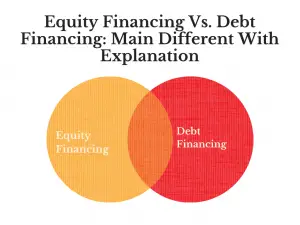Introduction
During the normal course of business, there are multiple scenarios requiring business owners to decide about finance.
Even though there are numerous different options available to raise finance, it can be seen that there are two broad categories of raising finance for the company, which can be referred to as equity financing and debt financing.

Equity Financing
As far as equity financing is concerned, it can be seen that it refers to raising financing by selling the company’s equity.
As a matter of fact, it can be seen that equity, in simple terms, can be defined as a certain percentage of ownership within the company.
Equity financing, therefore, means that the company plans on raising equity by selling off shares of the company to the general public.
In this case, it is also important to highlight that this is a form of external finance that the company raises. Therefore, it has certain positives and negatives that need to be considered to gauge its overall viability.
As far as the positives of equity financing are concerned, it can be seen that it is the amount that the company raises against ownership in the company.
If the company is not already listed on the stock exchange, the company needs to hold an IPO (Initial Public Offering) to be listed on the stock exchange.
After this, they can publicly sell their shares to the general public in exchange for money. Alternatively, business owners can also sell shares by forming a private limited company.
The greatest advantage of equity financing is that this is the amount that does not have to be paid back to the investors. However, they have to be compensated in dividends by the company owners to justify their investment.
Once these shares are sold, the company is liable to pay dividends whenever the dividends are announced annually.
However, the disadvantage of equity financing is that it dilutes the firm’s ownership structure, and the business owners ultimately end up losing control of the business.
Debt Financing
Speaking of debt financing, it can be seen that debt financing talks about raising finances by borrowing money. This amount of finance can be raised from investors, financial institutions as well as banks.
In most cases, it is considered a long-term loan, which needs to be paid back over the agreed-upon deadline.
When the finance is raised from debt financing, it can be seen that it incurs a certain interest or a financial charge that needs to be paid every year.
When raising finances through debt, business owners often have to provide security to the borrowers to guarantee that the amount would be paid back.
Therefore, business owners must have collaterals to offer as security to raise the significant amount of debt. In the same manner, it can be seen that the amount that is lent needs to be paid back.
Hence, it is often problematic because the company needs to arrange for a financing charge (interest) and the principle to pay back the loan.
However, the greatest advantage of raising money through debt financing is that the company can raise finance without compromising on the ownership structure. In other words, there is no shareholder dilution in this particular method of raising finance.
Conclusion
Therefore, it can be seen that from the available options, both of them have their own advantages as well as disadvantages.
However, different businesses have different priorities and financial positions depending on what they decide on which method to pursue when it comes to raising finance.
It must also be noted that smaller companies can’t sell their shares publicly, and therefore, they cannot always raise finances through equity.
Similarly, they can also not have significant resources to provide collateral in case of raising funds from debt financing.
Conclusively, it can also be seen that how companies decide the optimal structure is based on calculations that compare the cost of debt and the cost of equity.
Naturally, the optimal point of the debt and equity mix is when the cost of debt and cost of equity is the least.
